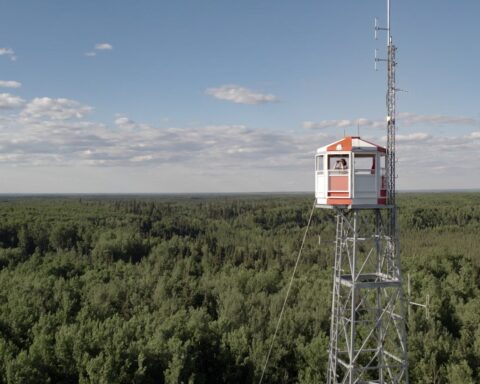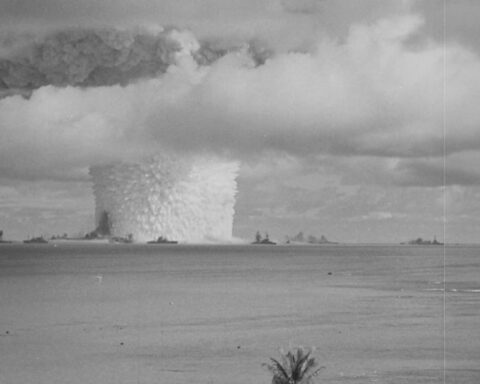There is no longer any reason to make films explaining the science behind climate change. An Inconvenient Truth has done its job.
What we need to know now is what can we do about it and, more importantly, what are we actually going to do about it?
This December saw what is fairly described as humanity’s best attempt at a solution: COP15, the United Nations Climate Change Conference in Copenhagen, Denmark. It was a gathering of tens of thousands of delegates, lobbyists, NGOs and activists from 192 nations—and filmmakers, who came to document the circus.
The high stakes meeting was just that: a circus—colourful and dramatic, but politically futile. And with delegates slashing their hands, demonstrators costumed as clowns, marches a hundred thousand strong, and activists beaten by police, fodder for good filmmaking.
The final accord is, in practical terms, meaningless. it is not legally binding; it sets no targets and is shady on the financial details. It simply acknowledges the need to limit the temperature rise to 2°C.
Though Copenhagen was full of sound and fury but accomplished nothing, it did at least signify something: the political process isn’t working, and local and individual efforts are not just important solutions but—for now—the only solutions.
This isn’t to say that the UN process is always inept. The Montréal protocol, signed in 1987 to ban chemicals that destroy the ozone layer, “proves that no matter how insurmountable the environmental crisis seems to be we can handle any challenge,” says Toronto filmmaker Mark Terry, director of the 2009 documentary Antarctica Challenge: A Global Warning.
Terry believes that his film “is one of the few climate change documentaries that is actually hopeful—most of them are a bit preachy and say ‘look at what you’ve done, we’re all going to die.’” Still optimistic, he feels that “if we all work together we can probably fix this.” His film presents new science from Antarctica. The ice caps are melting much faster than expected, and sea levels could rise much more quickly than was thought. Terry was one of the only filmmakers who presented inside the actual UN conference, as part of the Canadian delegation.
Antarctica Challenge, says Terry, influenced, “certain delegations to create resolutions for building flood defenses.” Though these resolutions were removed from the final draft, “it was encouraging to see a film take part in the process.” And though the deal was insufficient, “I think the accord was positive overall.”
Most political leaders share his view, and described the meeting as flawed but praiseworthy for acknowledging the need for action.
But many experts believe the UN talks are incapable of forging a real solution based both on science and on historical precedent.
The last accord, Kyoto, stipulated a six per cent cut in emissions. And atmospheric levels have risen steadily ever since. Canada increased its output by almost 30 per cent, and publicly stated that it would do so in breach of our legal commitment—confirming the impotence of the Accord.
Part of the problem is climate change is far more complex than ozone depletion, which was caused by a handful of chemicals. Climate change is impacted by and impacts upon every facet of our lives. What we eat, how we grow it, what we buy, how we make it, why we value it—all the threads of culture, society, politics and, above all, economics.
“Those who are opposed to addressing climate change have been very good at using that complexity as a way of sowing confusion and apathy,” says Sven Huseby, director of A Sea Change, a 2009 doc about oceanic acidification due to climate change.
Huseby screened his film at the Klimaforum09 alternative conference— open to everyone. “I still feel the excitement and delight from the Q&A.” He also marched with 100,000 people on December 12. “It was diverse, creative, peaceful, a thrill beyond belief to be in a sea of people there to bear witness,” says the 66-year-old. “It was a real throwback to the 1960s and the anti-war effort.”
The march demonstrated, if anything, that climate change is ultimately a social justice issue, and not an abstract “environmental” concept. It is about the simple staples of our lives—food, water and energy—who gets it, who doesn’t get it, and why. People marched not just for polar bears but for human rights.
“But,” he adds, “there were so many people with so many different messages, ranging from ‘down with capitalism’ to ‘seal the deal.’ They didn’t have a central focus like a war.”
And when a march five days later turned ugly, with riot police beating demonstrators, that message became even harder for observers thousands of miles away to understand through the prism of their television sets or from the footage posted online from “citizen journalists.”
For me, the violence was not just disturbing to witness first-hand, but also worrying in terms of the effect on the message. It becomes easier to see cops beating activists rather than the points they were trying to make. An observer could think the demonstrators were mere idealistic youths venting knee-jerk anti-capitalist rage without valid arguments. On the one hand they see thousands of delegates with suits, science, and tomes of policy couched in the complex language of legalese and the magical mathematics of finance. And on the other hand, angry anarchists with loud chants and puppets.
But the fact is that the demonstrators did have valid and informed criticisms shared with many academics and experts, such as James Hansen, head of the NASA Goddard Institute for Space Studies and perhaps the world’s most famous climate change scientist. They are not simply criticising the UN process for being slow and inefficient. They believe it could actually make the problem worse.
The main reason being that it is “a corporate strategy designed to be the least disruptive to economic growth and development,” says the narrator in Brenda Longfellow’s 2009 NFB co-production Weather Report. A key mechanism espoused by the UN is the “cap and trade” system, which allows permits to pollute to be bought and sold like a commodity. “This is wholly inadequate—it is a false hope,” says James Cameron, Vice-President of Climate Change Capital, in the film, which goes on to explain why we should be distrustful of “the market to correct the excesses that the market has created in the first place.”
“The elephant in the room here is that they won’t talk about the model—globalisation, deregulation, privatisation, and unlimited economic growth,” Maude Barlow said to me at Klimaforum09. She is the former senior Adviser on Water to the 63rd President of the United Nations General Assembly—and the co-author of Blue Gold, which was made into a 2007 documentary. “This is never going to work.”
Economics aside, one scientific conclusion is clear. Carbon dioxide in the atmosphere is already above risky levels, and therefore the UN process hasn’t worked. This may be due to the constraints of our economic system, or to an inescapable “tragedy of the commons” outcome. Either way, the process has not worked.
So was Voltaire right: is an enlightened dictator the only solution? I am tempted to think so.
In the meantime, in lieu of political leadership, what are we to do?
“Why do I have to wait for congress to do something?” asks Colin Beavan, a new York writer. Documented in the 2009 film No Impact Man, he and his wife (and toddler) cut down on every extraneous item, including meat, electricity, packaging and power, “to see if it is possible to have a good life without wasting so much,” he explains.
It isn’t easy: no food from beyond 250 miles (so no coffee or sugar), no packaging (so no take out), and no new unnecessary purchases. The day they run out of toilet paper is memorable.
But there are also unexpected gains. His wife learns to cook. He becomes fitter. They give up their television, spend more time outdoors, and “become better parents.” The experiment is more than an attention-grabbing gimmick. “A big question is whether one person can make a difference,” he comments. “But the thing about individual action is that it causes people to be engaged.”
The point is not trivial. The first step towards action is to engage with the issues, and to become aware that our acts of consumption contribute to climate change. That, in itself, is difficult. Comprehending how a cup of coffee with a plastic lid directly contributes to drought in Africa defies the imaginative capacities of most human minds.
But action can take more concrete forms. A Time Comes, Nick Broomfield’s 2009 Greenpeace short available free online, documents the experience of six activists who scaled a 200-metre smokestack of a coal-fired plant in England. They shut down the furnace temporarily but far more significant was the legal precedent set. They argued in court that the damage they caused was justified because it prevented greater damage to private property worldwide. And they won.
“Throughout history people have taken direct action and were lambasted but when you look back you realise they were right to do what they did,” says Ben Stewart, one of the six activists.
“But after a few years of activism you get exhausted,” says Mikael Rioux, a young man from Québec who sat suspended over the Trois-Pistoles River in protest of dams. He mellowed after the birth of his son and decided to search for real solutions. His story is documented in Sylvie van Brabant’s NFB doc Earth Keepers, winner of the 2009 Planet in Focus environmental film festival and screened in Copenhagen.
His journey takes him to see India’s recycling programmes employing slum youths, to meet Wangari Maathai, the Kenyan Nobel Prize winner who champions reforestation as economic development, and other progressive economists, and designers and thinkers.
The message is clear: the tools are there. We already have the right ideas and technology, and passionate and smart people ready to deploy them. And all it would take is two per cent of our global GDP.
(America spends more than four per cent of its GDP on its military budget). We have the means but we lack the political will.
“We should empower people to have faith in their own means…citizens must re-appropriate power,” concludes Rioux. “But people see that the problem is so big. How can we switch from fear to action?”
In this fight, “one moment is optimism, the next is apocalyptic despair,” says Jonathon Porritt of the Sustainable Development Commission in London, England, speaking in Earth Keepers. “We need to reach out to the young people who are both very passionate and very angry.”
But, Rioux wonders, “How can we remain optimistic and find the heart to keep on fighting?” Especially in Copenhagen in the midst of a bewilderingly complex meeting that came to almost nothing.
One evening in Copenhagen I met an unusual Canadian filmmaker. Slater Jewell-Kemker is 17 years old and making An Inconvenient Youth about “the people who really are experiencing climate change and working towards solutions,” she said. “Our leaders are not going to be around for the effects of their decisions, and the youth movement has something they don’t: enormous positive energy and creativity that prevents us from becoming depressed.”
She’s not the only Canadian teenaged climate change documentarian. Colin Carter, the director of 2009’s Fight For The Planet is in Grade 12.
“It is important for older activists like myself to pass the baton,” says Huseby. “We met a lot of terrific young people in Copenhagen who understood where to find the leverage points for change. The more I see of that, the better I feel for the sake of my grandchildren.”
Social struggles can succeed without violence. Gandhi was victorious in India and thanks to Martin Luther King, segregation came to an end in the US. I am grateful to be a woman today rather than a century ago. As No Impact Man—without toilet paper, electricity or heating—puts it: “The most radical political act is to be an optimist.”










